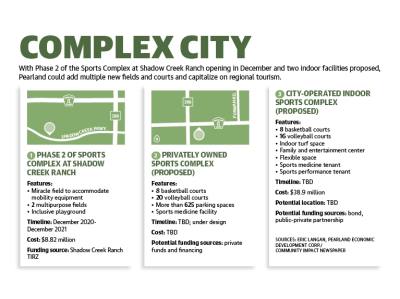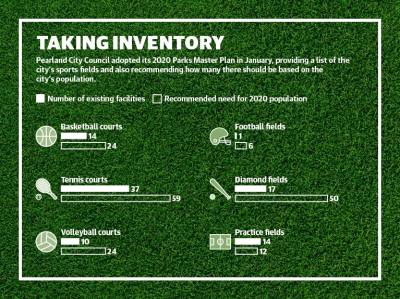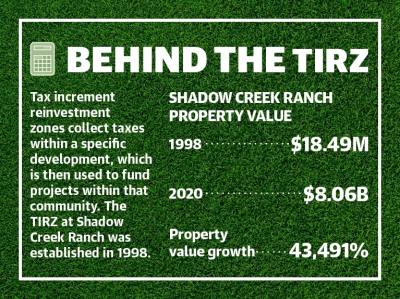As Pearland approaches completion of Phase 2 of the Sports Complex at Shadow Creek Ranch, which is expected to be mostly finished during December, city officials and a private developer are looking at the feasibility of bringing two more indoor facilities to the city as soon as possible.
Multiple city officials said these sports facilities could bring millions of dollars in tourism and economic impacts to the Pearland area.
“The benefit of [the Sports Complex at Shadow Creek Ranch] is [people] come and stay in our hotels,” Pearland Assistant City Manager Trent Epperson said. “They shop at our shops, they go eat in our restaurants and ... it helps our local economy when you’re able to have that dual purpose to where we normally service our citizens but you also have the opportunity to host larger tournaments.”
Meanwhile, Pearland City Council adopted its 2020 Parks Master Plan in January, which showed Pearland has 82 fewer sports fields and courts than the nonprofit National Recreation and Park Association recommends for a city of Pearland’s size. Each time the city looks to expand a park or green space, staff checks the plan to see what citizens identified as needs, Epperson said.
Sports complex draws
While the two complexes are in the early design stages, Phase 2 of the Sports Complex at Shadow Creek Ranch has been in construction since December 2020, Epperson said.
Phase 1 was completed in 2017 and included lighted softball and baseball fields, sand volleyball courts, a playground, paved walking paths and a covered pavilion.
Once complete in December, the sports complex will provide two new multipurpose fields that will be used for mainly cricket and rugby as well as a Miracle Field to accommodate wheelchairs and other mobility equipment.
Pearland’s first all-inclusive playground will also join the complex in the future, creating a space for children of all abilities and developmental stages. Construction is set to begin February on the playground, said Nikki Kamkar, board member at Forever Parks Foundation, a nonprofit organization that raised funds for the playground.
The $8.82 million second phase of the sports complex was funded mostly by the Shadow Creek Ranch Tax Increment Reinvestment Zone, which collects taxes within Shadow Creek Ranch and funds community projects, Epperson said.
About 4,000 people visit the facility each month for games and practices. Weekend tournaments attract about 600 additional visitors each month, Pearland Parks and Recreation Director Carry Capers said in an email. With Phase 2’s new features, the facility could attract roughly 2,000 more visitors each month, she added.
“Tournaments geared toward traveling teams align with our efforts at the [convention and visitors bureau] to generate visitors and overnight hotel stays,” said Tracy Rohrbacher, executive director of the Pearland Convention and Visitors Bureau.
After the Sports Complex at Shadow Creek Ranch opened in 2017, the city was able to attract Texas Amateur Athletic Federation’s Winter Games of Texas multisport event in 2018, Rohrbacher said. The TAAF returned in 2019 and early 2020 for more events.
The PCVB also secured a three-year deal with the United States Fastpitch Association in 2019 for Pearland to be the host city for a softball league, she said. Games were played at both the Sports Complex at Shadow Creek Ranch and Centennial Park, and it is estimated the league has brought $2.6 million to the city so far.
Future facilities
The Sports Complex at Shadow Creek Ranch’s three new fields in Phase 2 will contribute to the city of Pearland’s goal of increasing its sports fields.
The city’s parks master plan adopted in January showed Pearland has fewer sports fields and courts than recommended. The master plan included existing fields within neighborhoods, school districts, and parks and recreation facilities, Pearland Communications Director Joshua Lee said.
Additionally, Pearland City Council approved a zoning change Aug. 23 that opened the path for a proposed indoor sports complex at the southeast corner of Hwy. 288 and Beltway 8. With the zoning change, RCI Hospitality Holdings CEO Eric Langan plans to build a 100,000-square-foot sports complex on 11.25 acres of land that would feature eight basketball courts, at least 20 volleyball courts, a sports medicine facility and more than 625 parking spaces, Langan said at the meeting.
In a November statement to Community Impact Newspaper, Langan said he wants to bring an indoor facility to the intersection because of its access to major highways and Hobby Airport. He was unable to provide a timeline on when construction could begin.“We were able to acquire the large amount of land necessary for this project at lower rates than in other areas along major freeways,” he said.
During the Aug. 23 meeting, Council Member Trent Perez told Langan the city was pursuing its own indoor facility offering similar amenities.
In 2017, a feasibility study was done by a consultant to determine what type of multiuse event center would work best to draw more tourism in Pearland, and an indoor amateur sports complex was deemed as the best option for the city, Perez said.
However, City Council unanimously voted in June 2019 to postpone moving forward with the facility mainly due to the facility’s financials, such as the cost and revenue raised from visitor spending, not being at a level that appealed to council, Perez said.
After City Council’s decision, a different PEDC-led study was done in 2021 to see if the facility could still be viable for the city. The city’s proposed $38.9 million facility would include eight basketball courts, 16 volleyball courts, a potential indoor turf space, a family and entertainment center, and flexible space, according to documents from a special City Council meeting in April.
The city has not decided where the facility would be located but is exploring locations.
“I’m fully in support of it,” Perez said.
Financing future complexes
The city’s proposed facility could be funded by a public-private partnership or a future bond election, Perez said.
While Perez said he does not want the project to be rushed into a financing decision that could hurt the city in the long run, he said it needs to be done at a faster pace because Pearland risks losing the regional draw a sports complex brings.
“It’s a competitive market,” Perez said. “If we sit and wait for the stars to align, we could end up losing out on the opportunity if a neighboring community decides to move forward with a similar project.”
Ultimately, the city needs to consider all aspects a new indoor facility would bring to Pearland and its residents if it is built out, Perez said.
According to the PEDC, the net financial impact of the facility—accounting for its revenue and expenses, including operations and maintenance—would initially be a net negative for the facility’s first five years.
However, when accounting the money spent by those visiting the complex for tournaments, it would bring in an additional $15.73 million to the city in the first year, according to the PEDC’s 2021 analysis.
Spending by visitors would grow over time, and while the facility would be operating at a loss for the first five years of its existence, by year three the city would be garnering $20 million in money brought in by the complex’s visitors, according to the PEDC.
“Financially, we would need it to be a regional draw so people that do not live in Pearland would come to Pearland and spend money,” Perez said.









